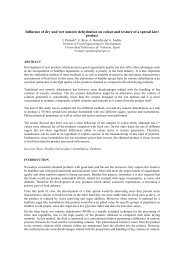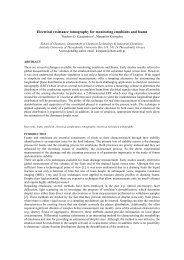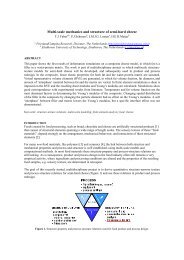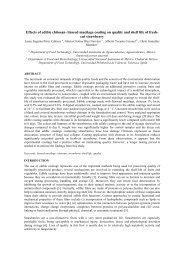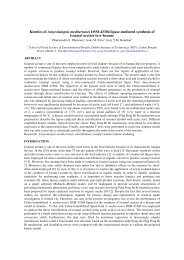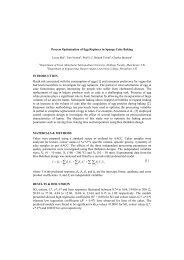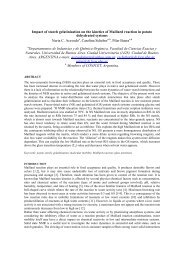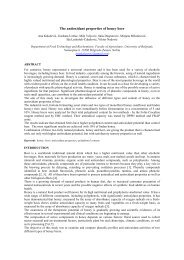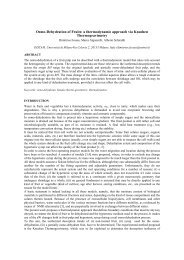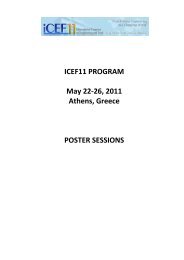Physical Stability of Beverage Emulsions as Influences - 11th ...
Physical Stability of Beverage Emulsions as Influences - 11th ...
Physical Stability of Beverage Emulsions as Influences - 11th ...
You also want an ePaper? Increase the reach of your titles
YUMPU automatically turns print PDFs into web optimized ePapers that Google loves.
<strong>Physical</strong> <strong>Stability</strong> <strong>of</strong> <strong>Beverage</strong> <strong>Emulsions</strong> <strong>as</strong> <strong>Influences</strong> <strong>of</strong> Orange Oil, Tragacanth<br />
and Arabic Gums Concentrations<br />
E. Rezvani 1 , A.R. Taherian 2 and G. Schleining 1<br />
1 Department <strong>of</strong> Food Science and Technology, BOKU-University <strong>of</strong> Natural Resources and Life Sciences,<br />
Muthg<strong>as</strong>se18, A-1190, Vienna, Austria (elham.rezvani@boku.ac.at) & (gerhard.schleining@boku.ac.at)<br />
2 Food Research and Development Center, Agriculture and Agri-Food Canada, 3600 C<strong>as</strong>avant West, St-<br />
Hyacinthe, Quebec J2S-8E3, Canada (ali.taherian@agr.gc.ca)<br />
ABSTRACT<br />
The objective <strong>of</strong> this study w<strong>as</strong> to examine the influence <strong>of</strong> tragacanth gum concentrations on physical and<br />
mechanical properties <strong>of</strong> beverage emulsions formulated with arabic gum and orange oil. <strong>Beverage</strong><br />
emulsions are oil-in-water emulsions and used to enhance juice-like appearance, to provide flavor and deliver<br />
functional ingredients (omega-3 fatty acids) to the beverages. <strong>Stability</strong> <strong>of</strong> beverage emulsions, in<br />
concentrated and diluted forms, is a chronic problem that plagues the flavor and beverage industries and is<br />
highly affected by certain physicochemical characteristics <strong>of</strong> polymeric emulsifiers (hydrocolloids gums)<br />
added into the water ph<strong>as</strong>e. The emulsions were prepared by adding 18-30% oil ph<strong>as</strong>e into hydrated arabic<br />
gum (6-12%), followed by addition <strong>of</strong> hydrated tragacanth gum (0.3-0.8%). The particle size distributions<br />
and zeta potential, surface tension, rheological properties and opacity stability <strong>of</strong> emulsions were<br />
characterized. Arabic gum decre<strong>as</strong>ed the surface tension between water and oil and therefore boosted up the<br />
stability <strong>of</strong> emulsions. Addition <strong>of</strong> oil w<strong>as</strong> readily responsible for incre<strong>as</strong>ing the opacity <strong>of</strong> the emulsions.<br />
Rheological properties were affected by changing the concentration <strong>of</strong> main components. All the emulsions<br />
show the flow behavior index less than 1 which means they posed shear-thinning behavior.<br />
Keywords: <strong>Beverage</strong> <strong>Emulsions</strong>; Tragacanth gum ; Arabic gum; Rheology and <strong>Stability</strong><br />
INTRODUCTION<br />
<strong>Beverage</strong> emulsions are cl<strong>as</strong>sified <strong>as</strong> oil-in-water emulsions and are prepared by dispersing oil ph<strong>as</strong>e<br />
containing flavour or vegetable oils, weighting agents and functional ingredients in water ph<strong>as</strong>e containing<br />
various types <strong>of</strong> hydrocolloid, acid, preservatives and colouring agents. The stability <strong>of</strong> cloud or flavour<br />
emulsion for a desired period <strong>of</strong> time is a common issue in the beverage industry [1-3]. Final beverages will<br />
be prepared by dilution <strong>of</strong> concentrated beverage emulsion in acidified sugar solutions. The emulsion in both<br />
concentrated and diluted form must be stable for at le<strong>as</strong>t 6 month [2, 4]. According to the Stokes’ law, the<br />
stability <strong>of</strong> beverage emulsion is highly depended on the specific gravity <strong>of</strong> water and oil ph<strong>as</strong>es, droplet size<br />
and the rheological characteristics <strong>of</strong> the continuous ph<strong>as</strong>e [5]. Hydrocolloids which are used to prepare the<br />
aqueous ph<strong>as</strong>e in beverage emulsions could provide specific rheological properties for achieving stability <strong>of</strong><br />
the emulsion. Gum arabic is the most commonly used biopolymer emulsifier in flavour beverage emulsion<br />
[2, 6]. This gum is able to form a film around oil particles and this could prevent the breakdown <strong>of</strong> emulsion<br />
due to steric stabilization and delaying coalescence [6, 7]. Mirhosseini& Tan reported that the concentration<br />
<strong>of</strong> arabic gum should be considered <strong>as</strong> a primary critical factor for the formulation <strong>of</strong> orange beverage<br />
emulsion [8]. Orange oils have been used <strong>as</strong> flavouring agents for many centuries. Recent studies have<br />
demonstrated that phytochemicals found in orange oil may also have health-promoting effects, such <strong>as</strong> anticarcinogenic<br />
and anti-inflammatory activities [9, 10]. Oil is the most important ingredient for providing a<br />
cloudy appearance and turbidity to beverages and the particle size <strong>of</strong> oil droplets plays a major role in<br />
beverage emulsion stability [11]. Gum tragacanth is an effective stabilizer <strong>of</strong> colloidal suspension at very low<br />
concentrations. The stabilization effect <strong>of</strong> tragacanth is a result <strong>of</strong> the steric repulsion force [12].<br />
Previous studies showed that emulsions b<strong>as</strong>ed on Arabic gum and tragacanth have a greater stability due to<br />
higher surface activity and higher stability to acid and heat by tragacanth gum [13]. Therefore, the objective
<strong>of</strong> this study w<strong>as</strong> to examine the influence <strong>of</strong> adding different levels <strong>of</strong> tragacanth gum <strong>as</strong> a stabilizer on the<br />
physical and mechanical properties <strong>of</strong> beverage emulsions formulated with arabic gum and orange oil.<br />
MATERIALS & METHODS<br />
Orange oil and Ester gum w<strong>as</strong> kindly granted by esarom Company (Oberrohrbach, Austria) and Arabic gum<br />
from TIC Gums. Tragacanth gum w<strong>as</strong> provieded by iranian local traders (Tehran, Iran). Sodium benzoate and<br />
pot<strong>as</strong>sium sorbate were used to reduce the chance <strong>of</strong> contamination in all prepared emulsions. Adjustment <strong>of</strong><br />
acidity w<strong>as</strong> done by food grade citric acid and di-sodium hydrogen phosphate. Dionized water w<strong>as</strong> used to<br />
prepare all the solutions.<br />
In order to estimate the effect <strong>of</strong> several mixture components on product properties a full 2^3 factorial<br />
experimental design w<strong>as</strong> carried out. As the sum <strong>of</strong> all components were 100% and to be able to combine all<br />
factors independently the ratio <strong>of</strong> the components to water have been used <strong>as</strong> factors.<br />
Arabic gum (18-30 %) and tragacanth gum (0.1-0.3 %) were dissolved separately in de-ionized water and<br />
stored overnight for complete hydration. Oil ph<strong>as</strong>e w<strong>as</strong> prepared by dispersing weighting agent (ester gum)<br />
into orange oil (1:1). Pre-emulsions were formed by stirring the oil ph<strong>as</strong>e (18-30 %) into the Arabic gum<br />
solution and then the solution <strong>of</strong> tragacanth gum w<strong>as</strong> added followed by pre homogenization. Further size<br />
reduction w<strong>as</strong> obtained by using a high pressure homogenizer.<br />
Rheological parameters were obtained using a rheometer (Bohlin CVO). The droplets size distribution w<strong>as</strong><br />
determined using a M<strong>as</strong>tersizer (Malvern) and the zeta potential w<strong>as</strong> me<strong>as</strong>ured by a Zet<strong>as</strong>izer (Malvern,<br />
Nano series). The opacity w<strong>as</strong> determined from the absorbance <strong>of</strong> diluted emulsions in 660 nm using a<br />
spectrophotometer (Shimadzu). Surface tension w<strong>as</strong> <strong>as</strong>sessed with the aid <strong>of</strong> a tensiometer (Krüss, E<strong>as</strong>y<br />
Dyne).<br />
RESULTS & DISCUSSION<br />
Opacity: As it is demonstrated in the standardized pareto chart (Fig. 1), incre<strong>as</strong>ing the oil concentration<br />
augment the opacity <strong>of</strong> emulsions. This effect is due to the scattering the larger fraction <strong>of</strong> light and this trend<br />
is the same in all concentration <strong>of</strong> tragacanth gum. The significant interaction shows that this effect w<strong>as</strong> also<br />
depend on the concentration <strong>of</strong> the other component.<br />
Surface tension: The surface tension w<strong>as</strong> directly proportional to the concentration <strong>of</strong> arabic gum (Fig. 2).<br />
Incre<strong>as</strong>ing the ratio <strong>of</strong> arabic gum to water decre<strong>as</strong>es the surface tension <strong>of</strong> emulsions from 47.2 to 43.1<br />
(mN/m). Garti and Reichman [14] reported that gum arabic behaves <strong>as</strong> a typical surface active protein and<br />
anchors strongly to oil ph<strong>as</strong>e via its proteinaceous part <strong>of</strong> the molecule and when this part is removed,<br />
denatured, or deactivated, the gum tends to lose its surface activity and emulsification capacity. Amphiphilic<br />
hydrocolloids such <strong>as</strong> arabic gum have the ability <strong>of</strong> film forming around droplets <strong>of</strong> oil particles which in<br />
turn prevents the breakdown <strong>of</strong> the emulsion owing to streic stabilization, thereby delaying coalescence.<br />
Particle size: Adding the oil concentration incre<strong>as</strong>e the particle size due to incre<strong>as</strong>e in volume ratio <strong>of</strong> oil.<br />
Tragacanth augmentation also incre<strong>as</strong>es the average size <strong>of</strong> the oil droplets (Fig. 3). This may be explained<br />
by the fact that tragacanth gum h<strong>as</strong> the affinity to interact with the arabic gum which already covers the<br />
droplets. Moreover, previous studies have shown for arabic gum stabilized emulsions, the addition <strong>of</strong> oil<br />
causes a clear incre<strong>as</strong>e <strong>of</strong> the average size <strong>of</strong> oil droplets and this effect could be seen clearly in less amount<br />
<strong>of</strong> Arabic gum[15].<br />
Zeta Potentail: As reported by Leiberman et al. [16], an absolute value <strong>of</strong> zeta potential less than -25 mV is<br />
indicative for flocculated emulsions. The zeta potential <strong>of</strong> our emulsions varied from -32 to -41 and therefore<br />
no flocculation h<strong>as</strong> been observed. As shown in Fig. 4, arabic gum and tragacanth decre<strong>as</strong>e the zeta potential,<br />
while oil incre<strong>as</strong>e the zeta potential.<br />
Rheological properties: Rheological flow parameters were also affected by concentration <strong>of</strong> arabic gum, oil<br />
or tragacanth gum. Oil and tragacanth decre<strong>as</strong>ed the flow behavior index (n) (Fig. 5) and incre<strong>as</strong>ed the<br />
consistency coefficient (k) (Fig. 6). All emulsions show the flow behavior index less than 1 which means<br />
they posed shear-thinning behavior.
C:Oil ph<strong>as</strong>e : Water<br />
A:Arabic gum : Water<br />
AB<br />
AC<br />
BC<br />
B:Tragacanth gum : Water<br />
+<br />
-<br />
0 1 2 3 4 5 6<br />
Figure 1. Standardized pareto chart for opacity<br />
A:Arabic gum : Water<br />
C:Oil ph<strong>as</strong>e : Water<br />
BC<br />
AB<br />
B:Tragacanth gum : Water<br />
AC<br />
+<br />
-<br />
0 2 4 6 8<br />
Figure2. Standardized pareto chart for surface tension<br />
C:Oil ph<strong>as</strong>e : Water<br />
B:Tragacanth gum : Water<br />
A:Arabic gum : Water<br />
AB<br />
AC<br />
BC<br />
+<br />
-<br />
0 2 4 6 8<br />
Figure3. Standardized pareto chart for particle size
A:Arabic gum : Water<br />
C:Oil ph<strong>as</strong>e : Water<br />
B:Tragacanth gum : Water<br />
AB<br />
AC<br />
BC<br />
+<br />
-<br />
0 1 2 3 4 5<br />
Figure 4. Standardized pareto chart for zeta potential<br />
C:Oil ph<strong>as</strong>e : Water<br />
B:Tragacanth gum : Water<br />
AB<br />
A:Arabic gum : Water<br />
+<br />
-<br />
AC<br />
BC<br />
0 2 4 6 8 10<br />
Figure 5. Standardized pareto chart for flow behaviour index<br />
C:Oil ph<strong>as</strong>e : Water<br />
A:Arabic gum : Water<br />
AC<br />
+<br />
-<br />
B:Tragacanth gum : Water<br />
BC<br />
AB<br />
0 2 4 6 8<br />
Figure 6. Standardized pareto chart for consistency coefficient
CONCLUSION<br />
Oil is mainly responsible for the opacity <strong>of</strong> beverage emulsion. Addition <strong>of</strong> arabic gum decre<strong>as</strong>es the surface<br />
tension between water and oil, hence, incre<strong>as</strong>ing the stability <strong>of</strong> emulsions. Hydrophobic interactions<br />
between the oil and proteins in tragacanth and arabic gums at the interface are responsible for the flow<br />
behavior and allow effective control for product development. The outcomes <strong>of</strong> this work may have practical<br />
applications for the design <strong>of</strong> industrial stable dispersions to provide opacity, flavor and to deliver functional<br />
ingredients into the beverages.<br />
REFERENCES<br />
1. McClements, D.J., Food <strong>Emulsions</strong>, Principles, Practices, and Techniques. second ed. 2005: CRC Press.<br />
2. Tan, C.-T., <strong>Beverage</strong> emulsions In: Food <strong>Emulsions</strong>. (S.E. Freiberg K. Larsson and J. Sjöblom, eds.), ed. 4th.<br />
2004, New York: Marcel Dekker.<br />
3. Taherian, A.R., P. Fustier, and H.S. Ram<strong>as</strong>wamy, Effects <strong>of</strong> added oil and modified starch on rheological<br />
properties, droplet size distribution, opacity and stability <strong>of</strong> beverage cloud emulsions. Journal <strong>of</strong> Food<br />
Engineering, 2006. 77(3): p. 687-696.<br />
4. Tse, K.Y. and G.A. Reineccius, Methods To Predict the <strong>Physical</strong> <strong>Stability</strong> <strong>of</strong> Flavor-Cloud Emulsion, in Flavor<br />
Technology. 1997, American Chemical Society. p. 172-182.<br />
5. Chanamai, R. and D.J. McClements, Dependence <strong>of</strong> creaming and rheology <strong>of</strong> monodisperse oil-in-water<br />
emulsions on droplet size and concentration. Colloids and Surfaces A: Physicochemical and Engineering<br />
Aspects, 2000. 172(1-3): p. 79-86.<br />
6. Chanamai, R. and D.J. McClements, Depletion Flocculation <strong>of</strong> <strong>Beverage</strong> <strong>Emulsions</strong> by Gum Arabic and<br />
Modified Starch. Journal <strong>of</strong> Food Science, 2001. 66(3): p. 457-463.<br />
7. Huang, X., Y. Kakuda, and W. Cui, Hydrocolloids in emulsions: particle size distribution and interfacial<br />
activity. Food Hydrocolloids, 2001. 15(4-6): p. 533-542.<br />
8. Mirhosseini, H. and C.P. Tan, Discrimination <strong>of</strong> orange beverage emulsions with different formulations using<br />
multivariate analysis. Journal <strong>of</strong> the Science <strong>of</strong> Food and Agriculture, 2010. 90(8): p. 1308-1316.<br />
9. Qian, C., et al., Comparison <strong>of</strong> Biopolymer Emulsifier Performance in Formation and Stabilization <strong>of</strong> Orange<br />
Oil-in-Water <strong>Emulsions</strong> ,Journal <strong>of</strong> the American Oil Chemists' Society, 2010. 88(1): p. 47-55.<br />
10. Dong, P., et al., Simultaneous determination <strong>of</strong> four 5-hydroxy polymethoxyflavones by reversed-ph<strong>as</strong>e high<br />
performance liquid chromatography with electrochemical detection, Journal <strong>of</strong> Chromatography A ,2010.<br />
1217(5): p. 642-647.<br />
11. Taherian, A., et al., Rheology and stability <strong>of</strong> beverage emulsions in the presence and absence <strong>of</strong> weighting<br />
agents: a review. Food Biophysics, 2008. 3(3): p. 279-286.<br />
12. A.Yokoyoma, K.R.S., and H. S. Fogler, Stabilization mechanism <strong>of</strong> colloidal suspensions by Gum Tragacanth.<br />
Journal <strong>of</strong> colloid and interface science, 1988. 126(1).<br />
13. Taherian, A.R., P. Fustier, and H.S. Ram<strong>as</strong>wamy, Steady and Dynamic Shear Rheological Properties, and<br />
<strong>Stability</strong> <strong>of</strong> Non-Flocculated and Flocculated <strong>Beverage</strong> Cloud <strong>Emulsions</strong>. International Journal <strong>of</strong> Food<br />
Properties, 2008. 11(1): p. 24-43.<br />
14. N. Garti, D. Reichman., Hydrocolloids <strong>as</strong> food emulsifiers and stabilizers. Food Structure, 1993. 12: p. 411-<br />
426.<br />
15. Elżbieta Dłużewska, A.S.a.M.M., Effect <strong>of</strong> oil ph<strong>as</strong>e concentration on rheological properties and stability <strong>of</strong><br />
beverage emulsion. Acta Sci. Pol., Technol. Aliment, 2006. 5(2): p. 147-156.<br />
16. Leiberman, H.A., Reiger, & M. M, Banker, G. S., Pharmaceutical Dosage Forms: Disperse Systems. Vol. 2.<br />
1989, New York, NY: Marcel Dekker.



